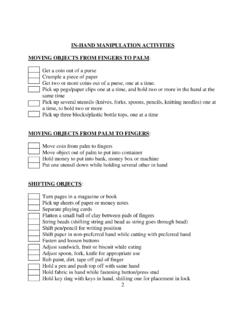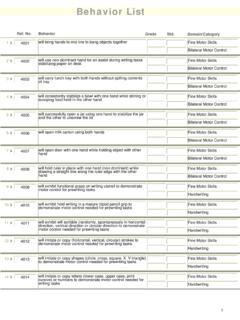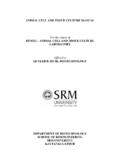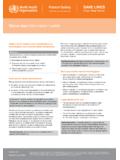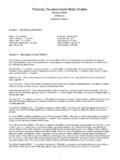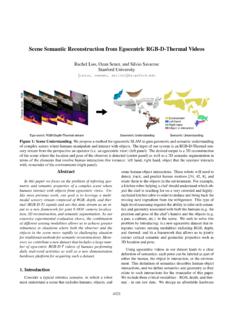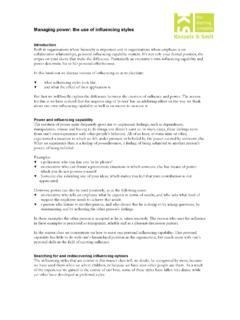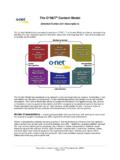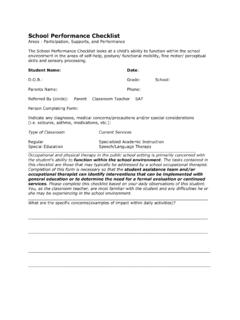Transcription of Nurturing young children’s physical well-being through ...
1 Information booklet: Nurturing young children s physical well -being through Fundamental movement skills (3-6 years)Information Booklet: Nurturing young children s physical well -being through Fundamental movement skills (3-6 years) movement skills Fundamental movement skills (FMS) support children s overall development especially their co-ordination and physical dexterity. Most importantly, they provide the building blocks for more advanced movements used by children as they become involved in and enjoy a range of different physical activities . In this way, FMS are important for enjoyable and successful participation in physical activities and sport in life.
2 The extent to which young children master these skills in early childhood, depends on the quality and variety of opportunities and experiences they can be divided into three categories: 1. locomotor skills like crawling, walking, running, galloping, skipping, jumping. 2. balance skills like climbing, bending, rolling, turning, stretching, twisting. 3. manipulation skills like throwing, catching, kicking and bouncing which are often called ball skills . young children benefit from spending significant amounts of time inside and outside everyday having fun moving their bodies and developing different movement skills . Being outdoors also gives them the freedom to explore the natural environment through climbing trees and splashing in puddles, and to experience big movements like running and galloping!
3 It is important to remember that each child develops at his/her own pace and a child of three years will be at a very different skill level from that of a six-year-old as will a child with particular physical disabilities. Every child needs opportunities to develop and practise FMS to the best of his/her ability and most of the suggested activities in this tip sheet can be adapted to suit children of differing abilities. Connections to Aistear and S oltaAistear Themes: well -being, Identity and Belonging, Communicating, Exploring and ThinkingGuidelines for good practice: Learning and developing through interactions ( ); Learning and developing through play ( ) S olta Standards1: Rights of the Child, , , 6: Play, , , : Health and Welfare, Digests linked to the above StandardsInformation Booklet: Nurturing young children s physical well -being through Fundamental movement skills (3-6 years) need lots of opportunities and time to master one FMS.
4 Lots of this practice can happen during child-initiated play. Risky play and play with open-ended materials are especially helpful. Playful, adult-led activities that include modelling and coaching are also important. Sections 1-3 give suggestions for helping children to develop the three categories of FMS. Section 1: Developing LOCOMOTOR skillsA. Running, running, children with the time, space and resources to run during child-initiated play. Ideas for adult-led activities might include running: backwards and forwards. following lines/shapes on the ground. at different speeds jogging, running, sprinting. to music at different speeds. carrying a ball.
5 through a ladder drawn on the ground. during games like chasing and football. on different surfaces such as grass, sand, gravel, paths. a distance and throwing a ball for children to catch during or at the end of the run. as part of an obstacle course with cones or cardboard boxes to combine running with dodging the Jumping, jumping, children with the time, space and resources to jump during child-initiated play. Ideas for adult-led activities might include jumping: in puddles. over pretend waves in the sea. different distances and seeing how many jumps it takes to get from one side of the space to the other. over canes or ropes on the ground.
6 Over low obstacles such as cones or cardboard boxes with bamboos sticks placed across to make a hurdle. from a height such as a bench, low wall, sturdy equipment or from a low branch on a tree. stretching upwards and reaching as far as they can with their arms. on a trampoline. in and out of a hula hoop. onto and off a mat. to music. Information Booklet: Nurturing young children s physical well -being through Fundamental movement skills (3-6 years) Galloping, galloping, children with time and space to gallop during child-initiated for adult-led activities might include galloping: forward with one foot leading and the other following (alternate feet).
7 In a sideways direction. with a partner . to music. games. D. Skipping, skipping, children with the time, space and resources to skip during child-initiated for adult-led activities might include skipping: alone long skips, high skips, backwards, forwards. following lines/shapes on the ground. with a partner. with a rope. games with others. actions as part of the game Simon 2: Developing BALANCE SkillsA. Climbing, climbing, children with time, space and resources to climb during child-initiated for adult-led activities might include climbing: up and down stairs. up and down, over and under and along playground equipment.
8 Up and down and across ladders made of rope. up and down large low-hanging trees and branches. up and down ramps. large rocks. using their hands only to move across obstacles, for example, using overhead Booklet: Nurturing young children s physical well -being through Fundamental movement skills (3-6 years) Balancing, balancing, children with the time, space and resources to balance during child-initiated play. Ideas for adult-led activities might include balancing: while walking on a low beam. while walking along low, large tree branches. while holding a beanbag on their heads and walking. on one foot and picking up a bean bag. Practise using both left and right feet.
9 On combinations of different body parts such as two feet and a hand. on one foot with eyes closed. Practise using both left and right feet. on two feet and placing legs wide to make a bridge. Roll a ball through the bridge. on four body parts to make a crab, for example, two hands and two feet. Encourage children to move forward, backwards and sideways! using pogo sticks, stilts, roller-skates. C. Rocking and rolling, rocking and rolling, rocking and children with the time, space and resources to rock and roll during child-initiated play. Ideas for adult-led activities might include: rocking on backs by holding the knees to their chest with their hands.
10 Tuck the chin into the chest. Progress to encouraging children to rock back onto their shoulders and forwards to get their feet flat on the ground after each rock. rolling with body stretched out like a pencil arms and legs stretched away. forward rolls tuck up into a small ball, chin into chest, take weight off shoulders and roll on a soft mat or grass. rolling on grassy hills and mats in all directions - in a pencil roll, forwards, Booklet: Nurturing young children s physical well -being through Fundamental movement skills (3-6 years) Cycling, cycling, children with the time, space and resources to cycle during child-initiated play. Ideas for adult-led activities might include cycling: with a variety of tricycles, bicycles, balance bikes, scooters and go-carts.
